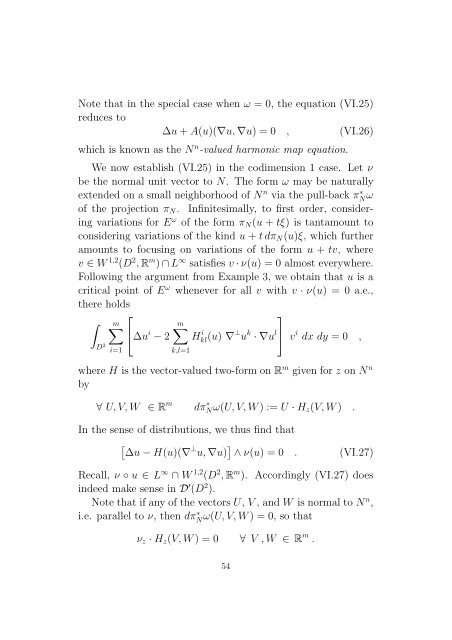Conformally Invariant Variational Problems. - SAM
Conformally Invariant Variational Problems. - SAM
Conformally Invariant Variational Problems. - SAM
Create successful ePaper yourself
Turn your PDF publications into a flip-book with our unique Google optimized e-Paper software.
Note that in the special case when ω = 0, the equation (VI.25)<br />
reduces to<br />
∆u+A(u)(∇u,∇u)= 0 , (VI.26)<br />
which is known as the N n -valued harmonic map equation.<br />
We now establish (VI.25) in the codimension 1 case. Let ν<br />
be the normal unit vector to N. The form ω may be naturally<br />
extended on a small neighborhood of N n via the pull-back πN ∗ ω<br />
of the projection π N . Infinitesimally, to first order, considering<br />
variations for E ω of the form π N (u + tξ) is tantamount to<br />
considering variations of the kind u+tdπ N (u)ξ, which further<br />
amounts to focusing on variations of the form u + tv, where<br />
v ∈ W 1,2 (D 2 ,R m )∩L ∞ satisfies v·ν(u) = 0 almost everywhere.<br />
Following the argument from Example 3, we obtain that u is a<br />
critical point of E ω whenever for all v with v · ν(u) = 0 a.e.,<br />
there holds<br />
⎡<br />
⎤<br />
∫<br />
m∑<br />
⎣∆u i −2 Hkl(u) i ∇ ⊥ u k ·∇u l ⎦ v i dx dy = 0 ,<br />
D 2 m<br />
∑<br />
i=1<br />
k,l=1<br />
where H is the vector-valued two-form on R m given for z on N n<br />
by<br />
∀ U,V,W ∈ R m dπ ∗ Nω(U,V,W) := U ·H z (V,W) .<br />
In the sense of distributions, we thus find that<br />
[<br />
∆u−H(u)(∇ ⊥ u,∇u) ] ∧ν(u) = 0 . (VI.27)<br />
Recall, ν ◦ u ∈ L ∞ ∩ W 1,2 (D 2 ,R m ). Accordingly (VI.27) does<br />
indeed make sense in D ′ (D 2 ).<br />
Note that if any of the vectors U, V, and W is normal to N n ,<br />
i.e. parallel to ν, then dπN ∗ ω(U,V,W) = 0, so that<br />
ν z ·H z (V,W) = 0 ∀ V ,W ∈ R m .<br />
54
















